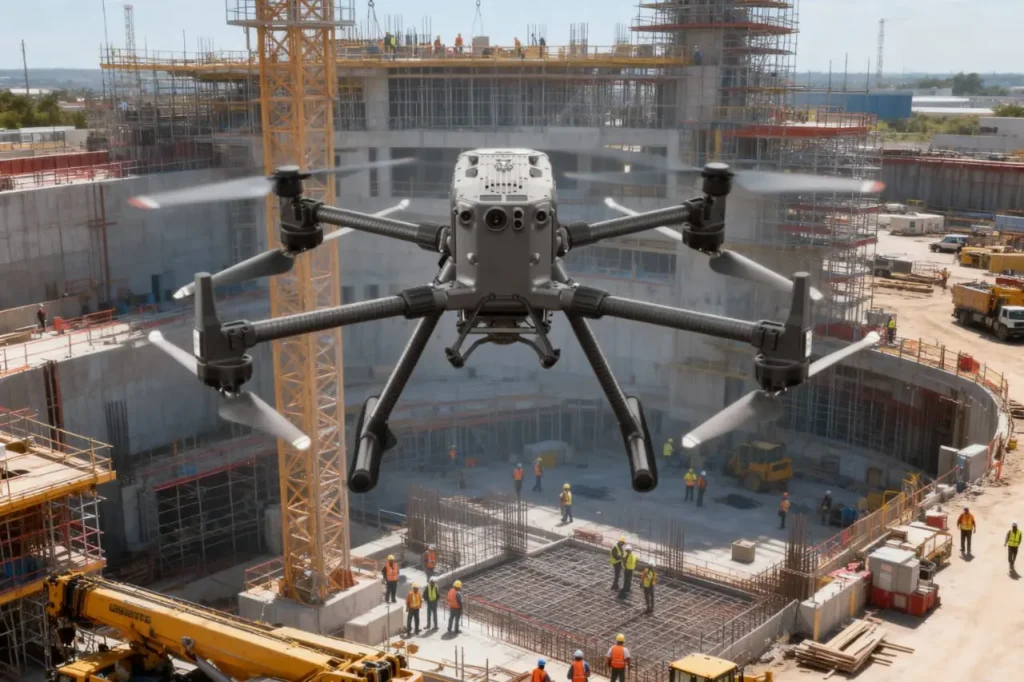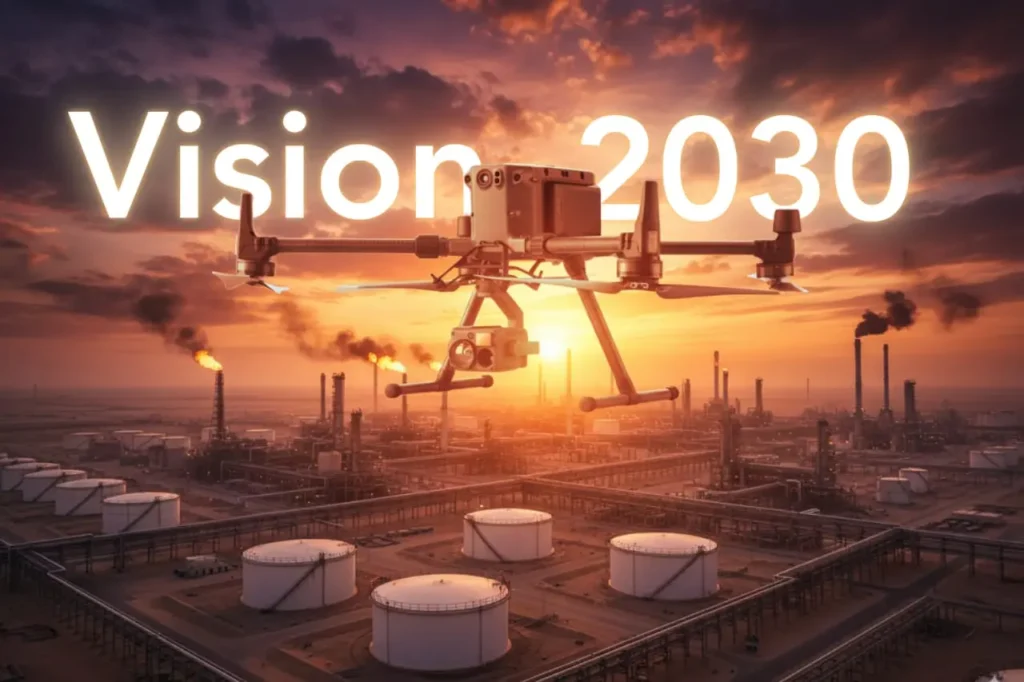Drone-Based Progress Tracking: Enhancing Accuracy, Safety, and Efficiency in Construction Projects

Highlight the Challenge in Project Monitoring Construction is a race against time, budgets, and safety risks. Projects involve thousands of moving parts, from contractors and materials to heavy machinery and schedules and keeping them aligned is one of the most difficult tasks in the industry. Progress monitoring is supposed to be the safeguard, yet in reality, it often becomes a bottleneck. Traditional site monitoring depends heavily on manual inspections and delayed reporting. Supervisors walk large areas, note down progress, and submit updates days or even weeks later. By the time this information reaches decision-makers, it is already outdated. This gap between planned schedules and actual progress on-site leads to missed deadlines, safety oversights, and costly inefficiencies. At the same time, construction sites themselves pose challenges: limited visibility across sprawling projects, safety risks during inspections, and technical constraints with point-based surveys. As a result, managers often work with incomplete or inaccurate data, a dangerous position when millions of dollars are at stake. The Cost of Monitoring Inefficiencies Industry data shows just how severe these challenges are. 22% of construction projects are delivered 250 days later than planned, while 13% experience delays of at least one year. The financial implications are staggering. Flyvbjerg’s research highlights that a one-year delay adds $1.2 billion in extra costs, or about $3.3 million per day. These numbers reveal that the issue is not only about missed schedules — it is about direct financial losses, strained relationships with stakeholders, and reputational damage for construction firms. In short, poor monitoring is not a small inefficiency; it is a systemic problem that erodes profitability and trust across the value chain. Demonstrate Benefits for Stakeholders The value of Drone-Based Progress Tracking extends far beyond visual updates. It directly empowers each stakeholder in the construction ecosystem with reliable data that improves accuracy, decision-making, and accountability. Stakeholder / Area Benefit from Drone-Based Progress Tracking Project Managers Access real-time dashboards, orthophotos, and time-lapse maps for faster decisions and early delay detection. Engineers Gain centimeter-accurate 3D point clouds for volumetric analysis, cut-fill calculations, and structural checks. Clients & Investors Receive transparent visual reporting via orthophotos, 3D digital twins, and virtual fly-throughs. Site Operations Reduce downtime since drone surveys do not interrupt ongoing construction activities. Safety Teams Lower risks by inspecting hazardous or hard-to-reach areas remotely, ensuring compliance and safer workflows. Cross-Team Coordination Integrate deliverables into BIM/GIS systems, aligning contractors, architects, and stakeholders on progress. In short, drones transform construction monitoring from a reactive process into a proactive one. Every stakeholder, from managers to engineers to investors, gains the clarity and confidence needed to deliver projects on time, within budget, and to specification. Encourage Adoption of Drone Solutions The case for adopting Drone-Based Progress Tracking is no longer about future potential. It is about immediate, measurable impact on accuracy, safety, and efficiency. For construction enterprises competing in fast-growing markets like Saudi Arabia, where Vision 2030 sets ambitious infrastructure and smart city goals, integrating drones into project monitoring workflows is becoming a necessity rather than an option. Start with Pilot Projects to Prove ROI Enterprises unsure of the value can begin with pilot projects on small to mid-sized sites. A single drone deployment can demonstrate how aerial mapping reduces survey time, improves reporting accuracy, and enhances safety. Data from these pilots often show 5 to 10 times faster survey speeds and measurable labor cost reductions, convincing stakeholders of the technology’s scalability. Integrate Drones into Existing Workflows Modern drones are designed to integrate seamlessly with project management and engineering tools. Orthophotos, point clouds, and 3D models produced by drones can be imported directly into BIM, GIS, or project scheduling platforms. This integration allows construction firms to maintain continuity without overhauling their workflows. Instead of replacing systems, drones add a new layer of speed and accuracy to existing processes. Scale with Specialized Service Providers Rather than investing heavily in equipment and training, many companies achieve rapid adoption by partnering with specialized drone service providers such as Terra Drone Arabia. These providers bring advanced hardware like LiDAR-equipped drones, trained pilots, and experienced data analysts, ensuring enterprise-grade results. Outsourcing drone services allows companies to scale monitoring across multiple sites while avoiding the risks of managing in-house fleets. Embrace Transparency and Safety Culture Adopting drone monitoring signals a cultural shift toward transparency and proactive safety management. With visual, data-driven evidence of site progress and hazards, disputes between contractors, project managers, and clients can be resolved objectively. Drone adoption also demonstrates a commitment to worker safety by reducing the need for hazardous manual inspections. This improves compliance with local safety standards and enhances corporate reputation. Incentives for Early Adoption To accelerate adoption and see measurable results before committing to long-term contracts. We offer a free 3-month drone progress monitoring program to reduce entry barriers. Looking Ahead: Industry 4.0 and Vision 2030 Alignment Drones are not an isolated innovation. They are part of a broader movement toward smart construction, where digital twins, IoT sensors, and AI-driven analytics work together to transform the built environment. Under Saudi Arabia’s Vision 2030 and Industry 4.0, drones will be standard tools for infrastructure development, helping ensure megaprojects are delivered on time, within budget, and at the highest safety standards. For companies that act now, adopting drones means not only solving today’s monitoring challenges but also positioning themselves as leaders in tomorrow’s smart construction ecosystem.
How Drones Cut Oil & Gas Inspection Time from 2 Weeks to 4 Hours

Capturing the Inspection Challenge Oil and gas remain central to Saudi Arabia’s economy and are critical to achieving the ambitions of Vision 2030. But maintaining the sector’s massive infrastructure from refineries and pipelines to storage tanks has always been a time-consuming, expensive, and risky process. Traditional inspections often rely on scaffolding, cranes, and shutdowns that disrupt operations for weeks at a time. Take the example of a diesel tank inspection. Traditionally, building and dismantling scaffolding, shutting down operations, and deploying manual crews could stretch the process to two weeks or more. During this period, the asset would be offline, resulting in millions of dollars in lost revenue. Now, drones are rewriting this story. The same inspection that once consumed two weeks was completed in just four hours using drones. That is a time savings of 13 days and 20 hours, transforming downtime into uptime and showing exactly why drones are a strategic pillar of Vision 2030. How Drones Transform Energy Operations The adoption of drones in oil and gas is not just about saving time; it is about transforming how the industry works. Faster Workflows: Drones bypass the need for scaffolding and manual climbs. With automated flight paths, they scan entire assets in hours, collecting high-resolution imagery and thermal data that can be analyzed immediately. High Accuracy: Drones equipped with zoom cameras, thermal sensors, and LiDAR detect cracks, corrosion, and leaks invisible to the naked eye. They capture centimeter-level detail, ensuring no defect goes unnoticed. Cost Efficiency: In energy and utilities, drone inspections can cut operational costs by 50–70%. They enable more frequent checks without shutdowns and reduce the manpower and equipment costs of traditional inspections. Safety Gains: Workers no longer need to scale flare stacks, powerlines, or refinery structures. By replacing risky climbs with aerial inspections, companies reduce workplace accidents in hazardous environments by as much as 91%. These technical advantages show why drones are not optional add-ons but enablers of efficiency, safety, and sustainability. Why This Matters for Vision 2030 Economic Efficiency: Faster inspections mean less downtime and higher productivity. Saving nearly 14 days of downtime in one inspection is not just impressive. It is transformative for an industry where every hour of output counts. Sustainability: Drones detect methane leaks faster and more frequently, reducing emissions by 30% or more. This supports the Kingdom’s environmental commitments under Vision 2030 and global climate frameworks. Safety and Social Impact: Reducing accident risk by 91% ensures that workers are safer, healthier, and more productive. This aligns with Vision 2030’s focus on enhancing quality of life. Cross-Sector Relevance: The same drone technology driving oil and gas efficiency also supports smart cities, utilities, agriculture, and environmental monitoring. By investing in drones, Saudi Arabia builds cross-industry capabilities that amplify the impact of Vision 2030. Drones are not just inspection tools; they are strategic assets that deliver measurable results across the national agenda. Roadmap for Scaling Drones in Vision 2030 To fully realize these benefits, Saudi Arabia must accelerate the adoption of drones across industries under Vision 2030. Regulatory Acceleration: Expand frameworks for safe beyond-visual-line-of-sight (BVLOS) operations, enabling drones to handle pipeline monitoring, logistics, and regional inspections without human oversight. Local R&D and Manufacturing: Invest in Saudi-based drone hardware, sensors, and data analytics platforms. This ensures the Kingdom builds sovereign capabilities and reduces reliance on imports. Ecosystem Platforms: Strengthen collaboration through platforms like SADEX, where regulators, operators, and innovators align standards, showcase real-world applications, and create joint ventures. Scaling Across Sectors: Move from pilots to national deployment by embedding drones into routine operations for oil and gas, utilities, smart cities, and agriculture. By following this roadmap, Saudi Arabia can position drones as a national infrastructure layer, not just a sector-specific tool.
